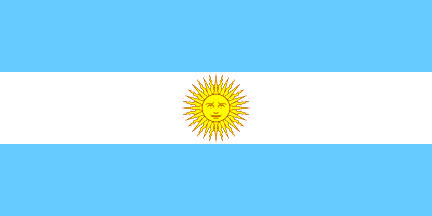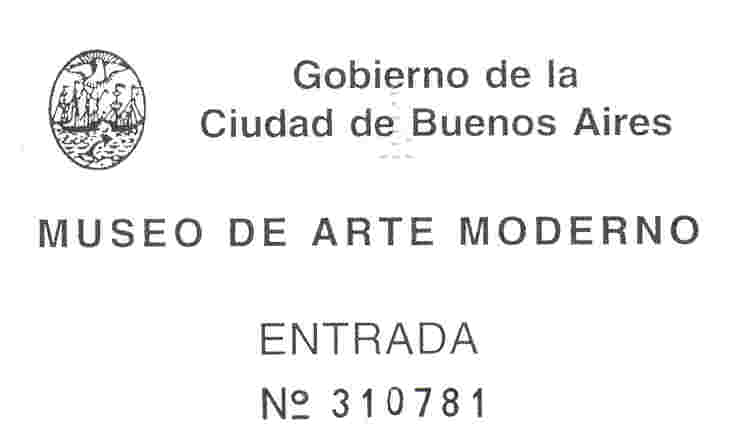|
|
Argentina 2002 |
It was another hot day in Buenos Aires. By the time I was ready to go adventuring, the bright sun had heated the area to about 85°F. I had planned to spend most of the day outside, so I made sure that I found a bottle of water to take with me.
I had planned to visit three southern barrios today, plus visit some of the parks that I missed the previous day. Because of the heat, however, I only strolled through the southern barrios - San Telmo, Constitución and Barracas - and returned to the Museo Nacional de Bellas Artes to purchase the two pre-Colombian artifact replicas that I had seen the previous day in the gift shop.
San Telmo
This is the first barrio south of the city center. After Buenos Aires was
refounded in 1580, a small settlement started in this area. It was known
originally as Alto de San Pedro, taking its name from the low-grade
patron saint of sailors. Most of the development occurred around the Plaza
de la Residencia, which was named as such because of the Jesuit residence
that was located around the corner from the square. As the settlement
grew, the square became a rest stop for ox carts that were carrying goods from
the port to the interior of the colony.
The area flourished in the 18th and 19th centuries, as it was home for many of the city's prominent and wealthy citizens. According to the Alive Guide guide, "[t[he majority of the homes were Spanish colonial with wrought-iron adornments on the doors and windows, and Andalusian-style balconies that were handmade for distinguished families ..." (Alive, 128). Many of these homes were centered on an interior courtyard, where the family entertained and remained cool during the hot summer months. Many of these courtyards have been transformed into antique stores and cafés.
|
|
|
| One of the interior courtyards. Notice the Andalusian-style balconies with wrought-iron accents | This courtyard has been transformed into several antique stores. On the second level was a small café, where people were enjoying brunch. |
After heavy rains, the streets often were muddy and littered with puddles. Locals often joked that small animals would drown in some of the larger puddles. It is believed that this situation caused the yellow fever outbreak in 1871. This epidemic killed hundreds of people, and caused the wealthier citizens to abandon their palatial estates for confines in Reloceta that were perceived as healthier.
The barrio fell into squalor and the former grand estates became tenement housing for the vast number of immigrants flooding the country. In the past couple of decades, the barrio has experienced a rebirth as an artist community. Many of the estates have been renovated into modern and trendy housing for the city's young. Unlike many of the city's other locales, San Telmo has retained its Spanish colonial feel. To a certain extent, it does feel like you are in a 16th c. CE Spanish colonial city.
|
|
|
| Shown here is a classic conventillo, which is characteristic of the barrio's dwellings | Some storefronts on Calle Defensa, the barrio's main street. These buildings give the barrio a Spanish colonial feel. |
Sundays are a popular day to visit the barrio, as there is a market in Plaza Dorrego, San Telmo's main square; it is known locally as the Feria de San Telmo. Selling all sorts of bric-à-brac, I had been told by some co-workers to make a special trip to San Telmo for this event. In planning the trip, I decided to arrange my Sunday adventures around a visit the market. After eating breakfast in the hotel room, I took a cab to the barrio and started the day.
The market was busy already - vendors were selling their wares and street actors were entertaining the masses. There were puppet shows, strolling musicians and mimes. In spite of the oppressively hot ambient temperature, the most was very festive. It was also the first time that I had seen many tourists in Buenos Aires; it seems that everyone had received the same advice as I did. I bought four old-time seltzer water bottles - two for me and two for mother's Christmas gift. Between the outdoor vendors and these Mercado San Telmo, which specializes perishable goods, there were plenty of stalls from which to browse.
|
|
|
| The festive nature of the Feria de San Telmo | The exterior of the Mercado San Telmo, one of the city's fruits and vegetables market |
On the east side of the the barrio is the Facultad de Ingenieria of the Universidad de Buenos Aires. The building was designed originally to house the Fundación Eva Peron, the charity organization of the former first lady. In Plazoleta Olazábal (also known as Plazoleta Eva Peron), the square facing the building, is a bronze statue entitled Canto al Trabajo. Created by Rogelio Yrurita, the statue shows nine laborers pulling a rock almost like horses pulling a wagon train.
|
|
|
| The Facultad de Ingenieria, née Fundación Eva Peron | Yrurita's Canto al Trabajo |
Just north of the Plazoleta is the Pasaje San Lorenzo, of which the Lonely Planet guide said, "... the cobbled [street] was once a rushing arroyo that impeded transport in colonial times" (LP3°). On this street is the Casa Mínima, described by the Time Out guide as "... an extreme version of the casa chorizo [ligterally, sausage house] style of house common throughout the city. Just two meters wide and fifty meters long, it was built by freed slaves in 1800 on a sliver of land bestowed on them by their master" (TO, 79). The pasaje hosts a crafts fair on the weekends, which really is not worth visiting.
|
|
|
| The Pasaje San Lorenzo hosts a craft fair on the weekends. It really isn't much and cannot compete with the Feria de San Telmo a few blocks south. | The Casa Mínima, which is an example of the city's casa choriza style. |
Near the Plaza Dorrego is the Iglesia Nuestra Señora de Belén. Construction of the church began in 1734 and was not completed until 1931. Built in the Baroque style, the church's whitewashed façade is accented with beautiful blue tiles. The dual belltowers are the barrio's tallest structures and each are crowned with a cross. Since I visited on a Sunday, a mass was in session. Next door is the former school that was operated by the Jesuits until their expulsion in 1767. In the early 1820s, the building was converted into a men's prison, then a women's prison until 1978. It now is the Museo Penitenciario Nacional, the national penitentiary museum. The courtyard also is used for a weekend fair.
|
|
|
| The twin spires of the Iglesia Nuestra Señora de Belén | An exhibit at the Museo Penitenciario Nacional |
Constitución
Since there no tourist attractions in this barrio, I did not venture into
Constitución. According to the Time Out guide, "[t]here
would be no palaces, politicians or poodles in the parks were it not for B[uenos]
A[ires]'s railways and warehouses that shifted meat and grain for export to
Europe and the wider world. Cross the tracks or walk under the motorway
flyovers around San Telmo and you enter Constitución ... [a] barrio that
are near the center but feel[s] like outskirts. Rarely explored by
tourists and doggy after dusk, [this] neighborhood has played an important role
in the less glamorous industrial and commercial history of the city" [TO,
86].
Barracas
Again, according to the Time Out guide, '[t]he name Barracas refers to
the warehouses that clustered here from the 18th c. CE onwards; cheap housing
and brothels completed the picture in the early 1900s. The place still has
an industrial fell about it, housing coming a poor, distant second ... Many
factories and warehouses have closed down, but there is still plenty to see in
the way of grand ruins and crumbling capitalism ..." (TO, 86).
On the way from San Telmo to Barracas is the Museo de Arte Moderno. Housed in a former tobacco warehouse, the museum shows mainly works by Argentine artists. I visited the museum to escape the heat of the early afternoon. I found it is an excellent space for the collection, though there wasn't much to see. Hopefully it will continue to be a venue for displaying art.
|
|
|
|
The façade of the Museo de Arte Moderno |
The admission ticket to the Museo de Arte Moderno |
I returned to the hotel to take a nap during the afternoon heat. After sleeping for a couple of hours, I did venture to the Museo Nacional de Bellas Artes to purchase the pre-Colombian artifact replicas that I had seen the previous day. I had dinner at Florida Garden in the Microcenter. Since it is similar to an American diner, I would not recommend it for a "special" dining experience. I returned to the hotel and slept well that evening.
Proceed to Day 6 - Monserrat and La Boca or return to
the Argentina Main Page

